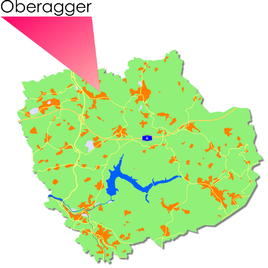Upper excavator
|
Upper excavator
municipality Reichshof
Coordinates: 50 ° 59 ′ 11 ″ N , 7 ° 39 ′ 8 ″ E
|
|
|---|---|
| Height : | 232 m above sea level NHN |
| Residents : | 603 (December 31, 2008) |
| Postal code : | 51580 |
| Area code : | 02265 |
|
Location of Oberagger in Reichshof
|
|
Oberagger is a district of the Reichshof municipality in the Oberbergischer Kreis in the North Rhine-Westphalian administrative district of Cologne in Germany . It has 625 inhabitants (as of January 1, 2007).
history
First mention
The place was first mentioned in a document in 1492 . "Heydenrych Kepenheuer (?) Van Offernacher is one of the witnesses in the establishment of the Bergisch rights in the Eigen von Eckenhagen."
The spelling of the first mention was Offernacher .
The powder mill in Oberagger, which was built at the end of the 17th century, was one of the best known in western Germany. Approx. 25 workers were employed in the mill. Black powder, a mixture of 75% saltpeter, 15% charcoal (obtained from the local buckthorn) and 10% sulfur was produced. The millstones come from Belgium and were brought to Oberagger by horse and cart. The weight of the 4 millstones is about 4 tons, the floor slabs weigh about 10 tons. Because of the danger of ignition of the powder, all iron was banned from the factory. Gears and transmissions were made of wood. Instead of the iron nails there were wooden pins. The workers were only allowed to wear wooden-nailed shoes. Even pocket knives were not tolerated in the pockets. Nevertheless, on the afternoon of March 9th, 1880, the great misfortune happened when the powder mill exploded and 2 workers were killed. The explosion could be heard far in the Oberbergischen and caused great damage in the vicinity. A permit for reconstruction was no longer granted due to the proximity to the site. The location of the powder mill was on today's Wiesenstrasse. Parts of the upper trench can still be recognized by the course of the stone excavator at the car park. The millstones have been submerged over the years and have almost been forgotten. In 1975 the millstones were remembered and started to be excavated. In August 1975 the millstones were transported to their current location at the village community center and then put back up. In the 18th century, iron-bearing sedimentary rocks were extracted in the St. Wilhelmina mine on the Acherberg.
Infrastructure
In Oberagger there is a village house as a meeting place for the village community, a football field and a small playground.
Celebrations and events
Oberagger has a war memorial for the fallen of World War II . Every year a wreath is laid there as part of a small celebration.
For some years now there has also been a small Christmas market every year, which is visited by many people from the Steinaggertal . The May Festival, which is traditionally celebrated every year on May 1st, is also very popular.
In addition, there are several bazaars every year, for example a toy bazaar in autumn / winter and several second-hand bazaars throughout the year. Almost traditionally, there is also a “beautification day” every year, during which clean-up work is carried out around the village house.
particularities
Oberagger has many residential areas with new homes built in recent years. For example, there is a large log house, a novel half-timbered house and many others.
our village should become more beautiful
The local community took part in the competition Our village should be more beautiful several times and received the silver plaque at the federal level in 1975.
Individual evidence
- ^ Klaus Pampus: First documentary naming of Oberbergischer places (= contributions to Oberbergischen history. Sonderbd. 1). Oberbergische Department 1924 eV of the Bergisches Geschichtsverein, Gummersbach 1998, ISBN 3-88265-206-3 .
Web links
- Website of the Oberagger village community (pictures)

